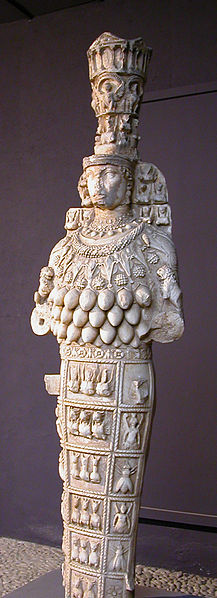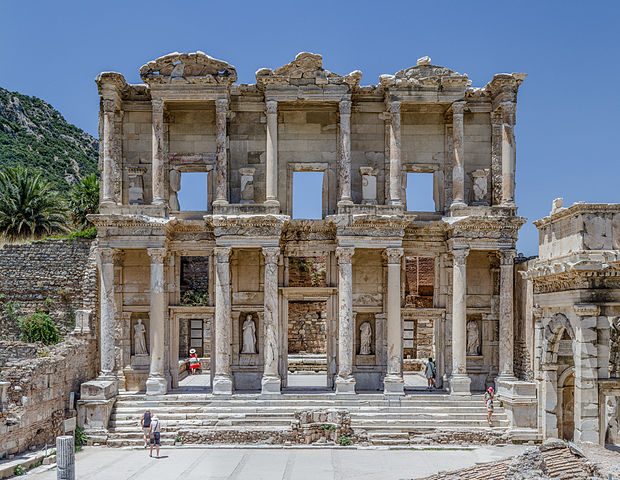Mysteries of Ephesus
.jpg)
The Ephesian Artemis with 2 five animal-faced side heads and 24 roundings under her breast as well as among other six times 3 animal heads at her legs - first 3 lions - bees at both sides - and external human figures reminds at tantric iconogaphy. There are several variants in the museum of Ephesos, also with three levels above the head.
A similar statue has especially variants at the top. Another black variant stands in the Capitoline Museum in Rome.
The Mysteries of Ephesus took place centrally in the Temple of Artemis at the Turkish west coast, until the temple 356 BC fell victim to a fire which was laid by Herostratos.
There, the spiritual students were led to experience of the creative world word (Logos). The temple of Artemis (Artemision, Artimus) was at the center here.

Artemis was regarded as a great mother-goddess and was represented in Greece with the holy deer Akoluthos as a companion(ind. vahana).
In the Iliad, Artemis is called the 'Lady of the Animals' (Potnia Theron). Her most famous attributes are otherwise the golden arrows and a silver bow, which was given to her by the Cyclops.
In Ephesus she had the broader meaning of a symbolic Yidam comparable to the kabbalistic Adam Kadmon. Therefore she was presented with expanded secret symbolism.
The many abundant deep 'breasts' symbolize the comprehensive spiritual heart - development : Several bees can be seen on the left leg of Artemis Epesia. The virgin priestesses of Artemis Ephesia called themselves Melissai or Melissae (Latin : female worker bees), possibly as an indication of the Amrita in the heart.
The bulls at her head point to the 'voice of silence' (logos), on which is also meditated in Nada-Yoga. The animals at her legs point to a knowledge as of the path of the Herakles etc..
The great Artemis of the Ephesians is even mentioned in ' History of the Apostles' 19.35.
Heraclitus (Herakleitos) of Ephesus (520 BC - 460 BC) was a pre-Socratic philosopher from the ionian Ephesus, who deposited his book in the Temple of Artemis in Ephesus as a temple-offering. He was famous for his insistence on ever-present change as being the fundamental essence of the universe. ('Listening not to me but to the logos it is wise to agree that one is all and all is one.')
Besides Artemis statues of goddesses such as Nike, Nemesis and Aphrodite were found in Ephesus.
Literature
- Die Philosophie des Heraklit von Ephesus im Lichte der Mysterienidee - Nebst einem Anhang über Heraklitische Einflüsse Im Alttestamentlichen Kohelet und Besonders Im Buche der Weisheit, Sowie in der Ersten Christlichen Literatur, Edmund Pfleiderer, 1936, (Adamant Media Corporation , 2002, ISBN-10: 0543698769 ISBN-13: 978-0543698766)
- Botten, Mick. (2012). Herakleitos – Logos Made Manifest, Upfront Publishing. ISBN 978-1-78035-064-6 All fragments, in Greek and English, with commentary and appendices.
- Sri Aurobindo : Heraklitus
- Ulrike Muss, Der Kosmos der Artemis von Ephesos, Wien 2001, ISBN 978-3-900305-36-9
- Die Lehre vom logos in der griechischen Philosophie, Heinze, Max, 1835-1909
- Geschichte der Logosidee in der griechischen Philosophie, Anathon Aall, 1896
- Der Logos-Begriff im Gedanken Heraklitus von Ephesos im Kontext der Geschichte der Philosophie und der Sprachphilosophie , Michael Wendland
- W. Kelber: Die Logoslehre. Von Heraklit bis Origenes. 1976.
- Kranz : Der Logos Heraklits und der des Johannes
- Fragments of a Faith Forgotten, G.R.S. Mead, 1906, S. 213
- Harris, William, translator (1994). "Heraclitus: The Complete Fragments: Translation and Commentary and The Greek Text" (PDF). Humanities and the Liberal Arts: Greek Language and Literature: Text and Commentary. Middlebury College. Retrieved 2007-10-09. Greek and English with DK numbers and commentary.
- Kirk, G.S. (1954). Heraclitus, the Cosmic Fragments. Cambridge: Cambridge University Press.
- Joachim von Sandrart I (1606-1688) The Ephesian Artemis from the Teutsche Academie

Weblinks
- Anthrowiki über die Mysterien von Ephesos
- Tempel der Artemis in Ephesos
- Die sieben Weltwunder: Der Artemistempel von Ephesos
- GA 8, Steiner, GA 8 Das Christentum als mystische Tatsache, Abschnitt : Griechische Mysterien - Heraklit
- Heraclitus translated
- Wikisource : Heraclitus fragments
of Spirituality
universal-path.org